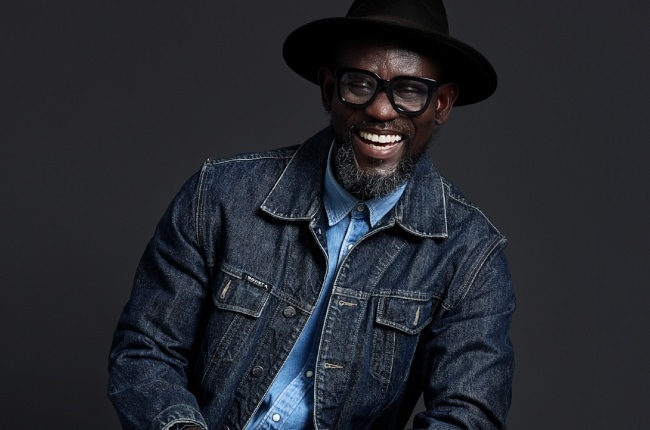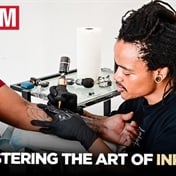
When he worked in front of the camera, it was a side hustle.
But as soon as he picked up a camera in a professional setting, he knew he had found his career.
And more than 10 years later, the camera is an extension of who he is.
Photography in its true sense, however, remains an art that requires both skill and having the eye, as photographers often say.
George Qua-Enon, known better as just George Q has both gifts.
George was born in Ghana and when he was 16, his family relocated to South Africa. He spent his formative years in Butterworth in the Eastern Cape.
“It was during my 10th grade that my passion for photography ignited. A family friend owned a photo studio at a local taxi rank, and I would often assist her after school, developing my film photographs in those pre-digital era days. It quickly turned into a hobby, with most of my early subjects being friends.”
His journey into photography took a more serious turn after he moved to Canada in 2004. A friend suggested he give modeling a shot, and he dabbled in this field as a side hustle for a while.
Read more | Sjava and Focalistic to go toe-to-toe in a sound clash
“During one of the modeling sessions, a photographer handed me his backup camera to play around with during a break. I spontaneously started capturing the other models in the studio, and it felt incredibly natural. I was captivated by the experience, which led me to make the decision to invest in a professional camera. In 2009, I transitioned into a full-me photographer, and I've been passionately pursuing this career ever since.”
He has now found the time right to impart some of his expertise through his own photography studio which he opened in Sandton recently.
A lord of the lens
Having been a photographer for some years now, he has picked up a few hacks that he uses to capture images the way he does.
“The most crucial part of taking a good image can vary depending on the context and your goals as a photographer, but several fundamental elements play a significant role in creating a compelling and visually pleasing image.
"These elements include composition which is often considered the foundation of a good image. It involves how you arrange the elements within the frame. Common compositional techniques include the rule of thirds, leading lines, framing, and balance. A well-composed image is visually appealing and draws the viewer's eye to the subject."
He emphasizes a few things from perspective and angles to the timing of a shot, but lighting remains a particular point of focus.
It is crucial in photography. The quality, direction, and intensity of light can dramatically affect the mood and atmosphere of an image. So, diffused lighting is often preferred for portraits, while dramatic lighting can work well for certain arcs or dramatic shots,” he explains.
“When capturing images, people frequently overlook critical aspects of photography. These include composition rules like the rule of thirds and framing, proper lighting, focus, camera settings, background clutter, horizon leveling, varied perspectives, storytelling, timing, and post-processing.
“Maintenance of camera equipment, safety precautions, permits and permissions, and respect image copyrights are also often neglected. Failing to plan shots or consider environmental conditions can result in missed opportunities. Prioritizing these elements is essential for producing high-quality, visually appealing images and avoiding potential legal issues.”
George’s quick-fire tips to photography
Having his own studio has been one of the main goals in his career. He was inspired to embark on this journey through his lifelong passion for photography, which has driven him to capture moments and tell stories through images.
“I've always found immense joy in this artistic pursuit, and I wanted to turn that passion into a profession. The concept of having my own studio not only allowed me to transform my love for photography into a career but also provided me with a dedicated space to bring my creative vision to life. This pursuit has been a deeply rewarding journey, and I'm grateful for the opportunity to achieve one of the central goals of my photography career.”
He believes that taking great pictures requires a combination of technical skill and creativity. He offers a few tips to help you better understand the technicalities involved in taking good photographs.
Read more | Meet the brains trust behind the Hey Neighbour music festival
“Know your camera, whether you're using a smartphone, a DSLR, or a point-and-shoot camera, familiarize yourself with its settings and capabilities. Lighting is crucial. Natural light is the best, so shoot outdoors or near windows when possible. Early morning and late afternoon offer warm light that's great for photography. Avoid harsh midday sunlight, which can create unflattering shadows.
He also suggests you pay attention to the composition of an image, “follow the rule of thirds: Divide your frame into a 3x3 grid and place your subject along the gridlines or at their intersections. Use leading lines (e.g., roads, rivers, or fences) to draw the viewer's eye into the photo. Experiment with different angles and perspectives to create interest.”
Having a central focal point is also an important thing to consider when aiming your camera at something you want to immortalize.
“Every photo should have a clear focal point. This is what you want the viewer to notice first. Isolate your subject from distractions in the background by using a wide aperture (low f-stop). Add depth to your photos by including foreground, middle ground, and background elements. Pay attention to the background; clutter or distractions can detract from your subject.”
The timing of a shot is also essential and being patient enough to capture a subject at the right moment can make or break a photo.
“Anticipate action in sports or wildlife photography and use burst mode for fast-paced events. Use the Golden Hour, the time shortly after sunrise and before sunset, offering so, warm, and flattering light.
He has spent a lot of his career taking in the work of other photographers that he admires across an array of disciplines within this avenue of art, and he would urge any aspiring photographers to do the same.
“Study the work of other photographers. Look for inspiration in books, magazines, websites, and social media platforms. The more you practice, the beer you'll become. Take your camera with you wherever you go and shoot regularly.”
Photography is art
He says it is important to have an understanding of the rules that govern this art form but that you shouldn’t shy away from breaking them too.
“While it's important to understand the basics, don't be afraid to break the rules and get creative Think about what story you want to tell with your photo. A strong narrative can make your image more compelling.”
“Remember that photography is an art, and there are no strict rules. Feel free to experiment and develop your own unique style. The more you practice and learn from your experiences, the beer your photography will become over time.”
For George one of his more memorable moments in his career involved capturing an iconic image of American actor and broadcaster William Shatner.
“Having grown up watching his television show, Rescue 911, I was thrilled when I received a call in Toronto to photograph him for his upcoming project. Meeting him in person was a moment of pure excitement. I vividly remember extending my hand to shake his, while expressing, "It's truly an honour to meet you, Mr. Shatner." His response was warm and casual as he replied, 'just call me Bill.' "
Their session was a fantastic experience, and it was made even more special when Bill invited George to join him and his wife for lunch after the shoot.
“Owning my photography studio has consistently ranked high among my aspirations, peculiarly since my return to South Africa in 2019. I had contemplated the move for some time, patiently biding my time. However, a health scare earlier this year reshaped my perspective, convincing me that life is too fleeting to wait for the elusive "right time."
Now is the moment to act.
His studio is open for rental to professional photographers, videographers, and production companies.
“The studio’s mission is to provide a collaborative and fully equipped environment that empowers professionals in the visual arts industry by offering state-of-the-art facilities, fostering a supportive community, and delivering comprehensive services.
“In the coming year, I will be hosting photography masterclasses and workshops specifically designed for beginners and intermediate-level photographers. I'm currently seeking freelance producers based in Johannesburg for collaborations. If you're a freelance producer interested in working together on advertising projects, please visit my website.”
He says that many people would argue that the photography industry has become saturated, “and while this may hold some truth, I firmly believe that setting your craft apart is the key to making your work shine. Embrace the wisdom of others, but also strive to uncover your unique voice.”



















